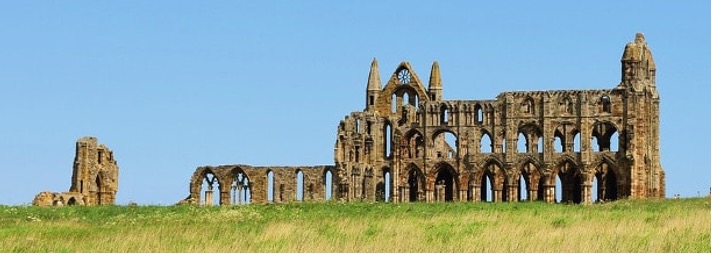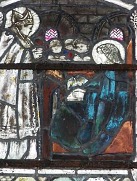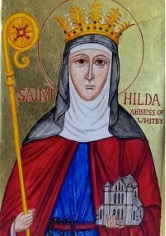
By Canon Ian Morter
This week I would like to focus our thoughts on one of the leading influencers of the Christian story in this country whose life dates back to the 7th Century, and we celebrate their feast day on Tuesday this coming week. This photograph is of the ruins in North Yorkshire that stand by the place where the focus of this influence was centred.
These are Gothic remains of the monastery that stands near the site where Hilda, or Hild as she was known in her native Celtic, founded the ancient monastic settlement, high on the exposed headland above the town we now call Whitby. Fortunately we have an account by the Venerable Bede of Hilda’s life recorded only 50 years after her death as he compiled the details of the arrival of Christianity in Britain. In his scholarly tome, The Ecclesiastical History of the English People we have the chief source of the historical and theological knowledge of the Anglo-Saxon world.
Bede tells us that Hilda was born in 614 to a royal household. Her father was the nephew of Edwin, the King of Deria, an Anglo-Saxon Northern kingdom. While Hilda was still a baby, her father was poisoned and she was raised in Edwin’s court. When she was around 33 years old, Hilda became a nun. She intended to join her sister, Hereswith, in the monastery of Chelles Abbey in Gaul, but was called back to Northumbria at the request of Bishop Aidan of Lindisfarne.
Hilda’s original convent is not known except that it was thought to be on the north bank of the River Wear. Hilda, with a few companions, lived out the traditions of Celtic monasticism, which Bishop Aidan brought from Iona. After a year Aidan appointed Hilda as the second abbess of Hartlepool Abbey. No trace remains of this abbey, but its monastic cemetery has been found near the present St Hilda’s Church, Hartlepool.

In 657 Hilda became the founding abbess of Whitby Abbey, then known as Streoneshalh, and she remained there until her death in 680. Archaeological evidence shows that her monastery was in the Celtic style, with its members living in small houses, each for two or three people. The tradition in double monasteries, such as Hartlepool and Whitby, was that men and women lived separately but worshipped together in church. Bede states that the original ideals of monasticism were maintained strictly in Hilda’s abbey. All property and goods were held in common; Christian virtues were exercised, especially peace and charity. Everyone had to study the Bible and do good works. Five men from this monastery later became bishops. Two, John of Beverley, Bishop of Hexham and Wilfrid, Bishop of York, were canonised for their service to the Christian Church in times of severe opposition from paganism. Bede describes Hilda as a woman of great energy, who was a skilled administrator and teacher. As a landowner she had many in her employ to care for sheep and cattle, farming, and woodcutting. She gained such a reputation for wisdom that kings and princes sought her advice. However, she also had a concern for ordinary folk such as Cædmon. He was one of the herdsman at the monastery, who was inspired in a dream to sing verses in praise of God. Hilda recognized his gift and encouraged him to develop it.

Hilda was not only the Abbess of two monasteries, she was also instrumental in hosting one of the most influential Synods of the English Church. The prestige of Whitby as a religious centre is reflected in the fact that King Oswiu of Northumberland chose Hilda’s monastery as the venue for the Synod of Whitby, the first synod of the Church in his kingdom. He invited churchmen from as far away as Wessex to attend the synod. Most of those present, including Hilda, accepted the King’s decision to adopt the method of calculating Easter to this day used in Western Church, thereby establishing the Roman practice as the norm in Northumbria and throughout the Anglo Saxon Kingdom. The monks from Lindisfarne, who would not accept this, withdrew to Iona, and later to Ireland.
We rejoice this coming week that Hilda of Whitby living between 614–68 was a Christian woman who was not only the founding abbess of the monastery at Whitby, but such an influential and more important figure in the Celtic Christianity, known for her wisdom. Bede, wrote of her; “All who knew her called her mother because of her outstanding devotion and grace”.